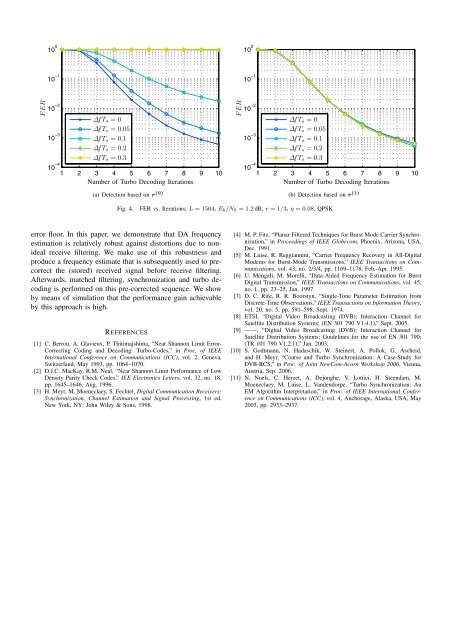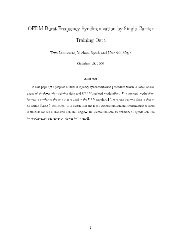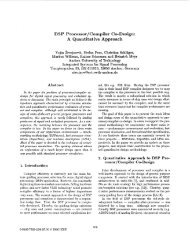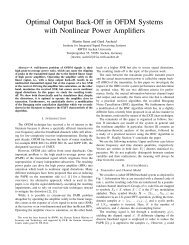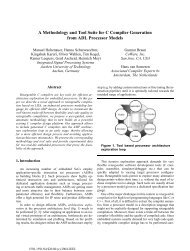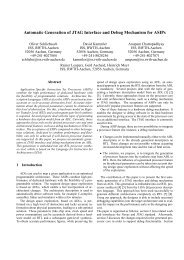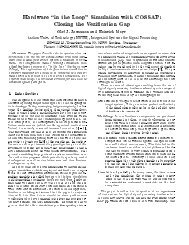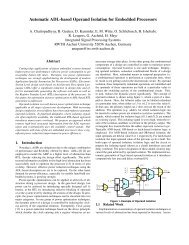Synchronization of Large Carrier Frequency Offsets at ... - IEEE Xplore
Synchronization of Large Carrier Frequency Offsets at ... - IEEE Xplore
Synchronization of Large Carrier Frequency Offsets at ... - IEEE Xplore
- No tags were found...
Create successful ePaper yourself
Turn your PDF publications into a flip-book with our unique Google optimized e-Paper software.
10 010 010 −110 −1FER10 −21 2 3 4 5 6 7 8 9 10∆f T s =0∆f T s =0∆f T s =0.05∆f T s =0.0510 −3∆f T s =0.110 −3∆f T s =0.1∆f T s =0.2∆f T s =0.2∆f T s =0.3∆f T s =0.310 −41 2 3 4 5 6 7 8 9 1010 −4(a) Detection based on r (0) (b) Detection based on r (1)Number <strong>of</strong> Turbo Decoding Iter<strong>at</strong>ionsNumber <strong>of</strong> Turbo Decoding Iter<strong>at</strong>ionsFER10 −2Fig. 4.FER vs. Iter<strong>at</strong>ions; L = 1504, E b /N 0 =1.2 dB, r =1/3, η =0.08, QPSKerror floor. In this paper, we demonstr<strong>at</strong>e th<strong>at</strong> DA frequencyestim<strong>at</strong>ion is rel<strong>at</strong>ively robust against distortions due to nonidealreceive filtering. We make use <strong>of</strong> this robustness andproduce a frequency estim<strong>at</strong>e th<strong>at</strong> is subsequently used to precorrectthe (stored) received signal before receive filtering.Afterwards, m<strong>at</strong>ched filtering, synchroniz<strong>at</strong>ion and turbo decodingis performed on this pre-corrected sequence. We showby means <strong>of</strong> simul<strong>at</strong>ion th<strong>at</strong> the performance gain achievableby this approach is high.REFERENCES[1] C. Berrou, A. Glavieux, P. Thitimajshima, “Near Shannon Limit Error-Correcting Coding and Decoding: Turbo-Codes,” in Proc. <strong>of</strong> <strong>IEEE</strong>Intern<strong>at</strong>ional Conference on Communic<strong>at</strong>ions (ICC), vol.2,Geneva,Switzerland, May 1993, pp. 1064–1070.[2] D.J.C. MacKay, R.M. Neal, “Near Shannon Limit Performance <strong>of</strong> LowDensity Parity Check Codes,” IEE Electronics Letters, vol. 32, no. 18,pp. 1645–1646, Aug. 1996.[3] H. Meyr, M. Moeneclaey, S. Fechtel, Digital Communic<strong>at</strong>ion Receivers:<strong>Synchroniz<strong>at</strong>ion</strong>, Channel Estim<strong>at</strong>ion and Signal Processing, 1st ed.New York, NY: John Wiley & Sons, 1998.[4] M. P. Fitz, “Planar Filtered Techniques for Burst Mode <strong>Carrier</strong> <strong>Synchroniz<strong>at</strong>ion</strong>,”in Proceedings <strong>of</strong> <strong>IEEE</strong> Globecom, Phoenix, Arizona, USA,Dec. 1991.[5] M. Luise, R. Reggiannini, “<strong>Carrier</strong> <strong>Frequency</strong> Recovery in All-DigitalModems for Burst-Mode Transmissions,” <strong>IEEE</strong> Transactions on Communic<strong>at</strong>ions,vol. 43, no. 2/3/4, pp. 1169–1178, Feb.-Apr. 1995.[6] U. Mengali, M. Morelli, “D<strong>at</strong>a-Aided <strong>Frequency</strong> Estim<strong>at</strong>ion for BurstDigital Transmission,” <strong>IEEE</strong> Transactions on Communic<strong>at</strong>ions, vol. 45,no. 1, pp. 23–25, Jan. 1997.[7] D. C. Rife, R. R. Boorstyn, “Single-Tone Parameter Estim<strong>at</strong>ion fromDiscrete-Time Observ<strong>at</strong>ions,” <strong>IEEE</strong> Transactions on Inform<strong>at</strong>ion Theory,vol. 20, no. 5, pp. 591–598, Sept. 1974.[8] ETSI, “Digital Video Broadcasting (DVB); Interaction Channel forS<strong>at</strong>ellite Distribution Systems; (EN 301 790 V1.4.1),” Sept. 2005.[9] ——, “Digital Video Broadcasting (DVB); Interaction Channel forS<strong>at</strong>ellite Distribution Systems; Guidelines for the use <strong>of</strong> EN 301 790;(TR 101 790 V1.2.1),” Jan. 2003.[10] S. Godtmann, N. Hadaschik, W. Steinert, A. Pollok, G. Ascheid,and H. Meyr, “Coarse and Turbo <strong>Synchroniz<strong>at</strong>ion</strong>: A Case-Study forDVB-RCS,” in Proc. <strong>of</strong> Joint NewCom-Acorn Workshop 2006, Vienna,Austria, Sep. 2006.[11] N. Noels, C. Herzet, A. Dejonghe, V. Lottici, H. Steendam, M.Moeneclaey, M. Luise, L. Vandendorpe, “Turbo <strong>Synchroniz<strong>at</strong>ion</strong>: AnEM Algorithm Interpret<strong>at</strong>ion,” in Proc. <strong>of</strong> <strong>IEEE</strong> Intern<strong>at</strong>ional Conferenceon Communic<strong>at</strong>ions (ICC), vol. 4, Anchorage, Alaska, USA, May2003, pp. 2933–2937.


